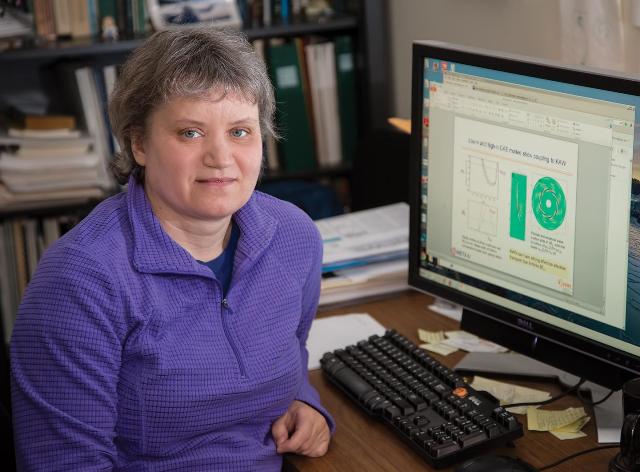Aug 4 2015
Creating controlled fusion energy entails many challenges, but one of the most basic is heating plasma - hot gas composed of electrons and charged atoms - to extremely high temperatures and then maintaining those temperatures.
Now scientist Elena Belova of the U.S. Department of Energy's (DOE) Princeton Plasma Physics Laboratory (PPPL) and a team of collaborators have proposed an explanation for why the hot plasma within fusion facilities called tokamaks sometimes fails to reach the required temperature, even as researchers pump beams of fast-moving neutral atoms into the plasma in an effort to make it hotter.
 This is PPPL Scientist Elena Belova. Credit: Elle Starkman/Princeton Plasma Physics Laboratory
This is PPPL Scientist Elena Belova. Credit: Elle Starkman/Princeton Plasma Physics Laboratory
The results, published in June in Physical Review Letters, could lead to improved control of temperature in future fusion devices, including ITER, the international fusion facility under construction in France to demonstrate the feasibility of fusion power. This work was supported by the DOE Office of Science (Office of Fusion Energy Sciences).
The researchers focused on the puzzling tendency of electron heat to leak from the core of the plasma to the plasma's edge. "One of the largest remaining mysteries in plasma physics is how electron heat is transported out of plasma," said Jon Menard, program director for PPPL's major fusion experiment, the National Spherical Tokamak Experiment-Upgrade (NSTX-U), which is completing a $94 million upgrade.
Belova hit upon a possible answer while performing 3D simulations of past NSTX plasmas on computers at the National Energy Research Scientific Computing Center (NERSC), in Oakland, California. She saw that two kinds of waves found in fusion plasmas appear to form a chain that transfers the neutral-beam energy from the core of the plasma to the edge, where the heat dissipates. While physicists have long known that the coupling between the two kinds of waves - known as compressional Alfvén waves and kinetic Alfvén waves (KAWs) - can lead to energy dissipation in plasmas, Belova's results were the first to demonstrate the process for beam-excited compressional Alfvén eigenmodes (CAEs) in tokamaks.
Her simulations showed that when researchers try to heat the plasma by injecting beams of energetic deuterium, a form of hydrogen, the beams excite CAE waves in the plasma's core. Those waves then resonate with KAW waves, which occur primarily at the plasma's edge. As a result, the energy is transported from the injection site deep within the plasma to the plasma's edge.
"Originally, when scientists found that the electron temperature wouldn't go up with increased beam power, everybody assumed that the electrons were getting heated at the plasma's center and then were somehow losing that heat," Belova said. "Our explanation is different. We propose that part of the beam energy goes into CAEs and then to KAWs. The energy then dissipates at the plasma's edge."
The simulations provided a broad perspective. "In simulations you can look everywhere in a plasma," Belova said. "In the experiments, on the other hand, you are very limited in what and where you can measure inside the hot plasma."
Belova's findings reflect the growing collaboration between theoretical and experimental research at the Laboratory. Her results could enhance understanding of electron energy transport in experiments on the NSTX-U, said Amita Bhattarcharjee, head of the Theory Department at PPPL.
Belova plans to run more simulations to determine whether the mechanism she identified is the primary process that modifies the electron heating profile. She will also look for ways in which physicists can avoid this wave-induced change in the profile. In the meantime, she is driven by her desire to learn more physics. "We want to understand how these waves are excited by the beam ions," she said, "and how to avoid them in the experiments."